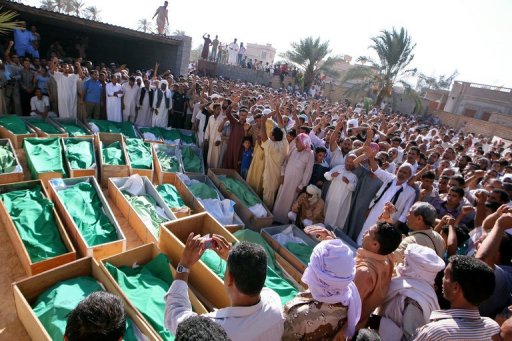[captionpix align=”left” theme=”elegant” width=”320″ imgsrc=”http://www.hrw.org/sites/default/files/media/images/photographs/2011_Libya_natoattacks.jpg” captiontext=” A funeral for the 34 victims in the rural town of Mayer. (Photo: Human Rights Watch)”]
In March 2011 NATO allies embarked on a 222-day mission to end systemic violations of human rights by the regime of Colonel Gaddafi. The goal of Operation Unified Protector (OUP) was to enforce an arms embargo and no-fly zone, supported by air strikes until all attacks on civilians ended, and Gaddafi’s forces were sent back to the barracks. While OUP’s mission centered on protecting civilians from human rights violations, there were 72 civilian casualties reported during the course of the military campaign, an admittedly low number. Nonetheless, human rights groups, such as Amnesty International and Human Rights Watch (HRW), are rightfully holding NATO accountable to these fatalities and have urged for an investigation into the causes of the civilian casualties.
From the beginning of NATO’s air campaign in Libya, the Alliance has proclaimed its dedication to minimizing civilian casualties. In so doing, NATO adopted procedures in compliance with international humanitarian law applicable to armed conflict to minimize the risks of causing civilian deaths. These tactics included the exclusive use of precision guided weapons and a strict selection process of individual targets. In addition, the campaign issued prior warnings to residents of the areas being targeted. Moreover, before authorizing certain strikes, as much as 50 hours of video observation was analyzed. Hundreds of planned strikes were aborted at the last minute due to the perceived possibility of a civilian presence.
Operation Unified Protector was, overall, very effective at minimizing innocent deaths, with 72 civilian casualties resulting from 9, 700 strikes and 7, 700 precision bombs on approved targets. NATO maintains that it only struck legitimate military targets. However, the complex military campaign was complicated by Gaddafi’s soldiers operating out of civilian infrastructure and wearing civilian clothing. There is also the claim that the Gaddafi regime placed dead bodies of civilians his troops killed at sites following NATO explosions. Moreover, the mandate of the intervention did not include ground troops making it harder to verify targets, thereby raising significant doubt about the causes of civilian casualties.
These circumstances, which cause concerns regarding the number of civilian deaths during NATO’s air campaign, require an investigation. Amnesty International suggests that these casualties could have been the result of erroneous GPS coordinates and intelligence or weapon malfunction. Their concern is NATO’s perceived lack of transparency. They are demanding that the Alliance recognize its fault in these deaths and compensate the families. HRW has also stated that their assessment of civilian casualties has demonstrated a possibility of laws-of-war violations since women and children civilians have reportedly been victims of NATO’s operations. Laws of war refers to acceptable military actions during warfare, as dictated by international law. Part of this doctrine involves exclusively targeting military personnel. If NATO failed to abide by international law in Libya, the Alliance must be held accountable.
NATO refutes these claims of weapon malfunction and laws of war violations, and the Alliance has expressed sympathy for the civilian fatalities. NATO spokeswoman Oana Lungescu stated: “NATO conducted the campaign for Libya with unprecedented care and precision and to a standard exceeding that required by international humanitarian law.” A claim to which the low number of civilian casualties attests. The Alliance asserts that an investigation into these deaths is beyond the mandate authorized by the UN, as it does not allow for NATO’s involvement in Libya following the termination of OUP on 31 October 2011. The responsibility of the investigation, therefore, rests with the Libyan authorities. NATO has openly endorsed its support to any investigation by the Libyan authorities into civilian casualties.
There are significant benefits to human rights groups pressuring NATO to investigate civilian casualties. Firstly, it holds NATO accountable for actions and consequences of its military campaign. Secondly, it gives closure and justice to the victims. However, the split within the UN over NATO’s operational tactics complicates NATO’s future involvement in humanitarian missions. Russia, China, South Africa, and India claim that the Alliance overstepped its mandate in Libya, while the Western Alliance maintains that contributing to the fall of Gaddafi was within the legalities of the mandate. This debate over NATO’s involvement in Libya has also complicated the adoption of a similar humanitarian mission in Syria. Given the increasing importance of regional military alliances for multilateral peace operations and the disagreement over NATO’s involvement in Libya, it is wise for NATO to stay within the parameters of the UN mandate and leave the humanitarian investigation to the Libya authorities. In turn, NATO should openly support these investigations and accept legitimate criticisms towards its operations in Libya that resulted in civilian casualties and factor in the lessons learned into future deployments.




